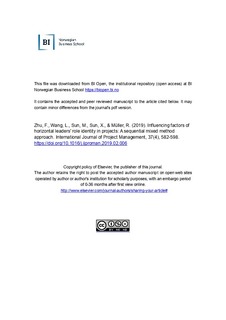Influencing factors of horizontal leaders' role identity in projects: A sequential mixed method approach
Journal article, Peer reviewed
Accepted version

View/
Date
2019Metadata
Show full item recordCollections
- Publikasjoner fra CRIStin - BI [1015]
- Scientific articles [2181]
Original version
International Journal of Project Management. 2019, 37 (4), 582-598. 10.1016/j.ijproman.2019.02.006Abstract
Horizontal leadership is temporary and often short-term compared with vertical leadership. Therefore, the role identity of horizontal leaders' is more difficult to be legitimated. In this study, we investigated how different factors interact and work in concert to influence horizontal leaders' role identity (hereafter, HLs' role identity). A sequential mixed method approach was chosen to conduct this research. Twenty-four interviews were analysed, and we identified eleven influencing factors associated with HLs' role identity. Subsequently, a sample of 150 questionnaires was analysed by using fuzzy-set qualitative comparative analysis (fsQCA) to ascertain the collective effect of different influencing factors on HLs' strong and weak role identities. The results showed that high job complexity, intrinsic rewards, self-efficacy and personal expectations were the necessary conditions for HLs' strong role identity. The lack of expectations of other team members was the only necessary condition that resulted in HLs' weak role identity. Based on the 13 configurations of HLs' strong and weak role identities that were obtained from this research, we formed an HLs' role identity model. It was found that the expectations of other project team members together with empowerment by project managers are the most common and effective ways to establish HLs' strong role identity. Through a comparison, experienced and less experienced team members take different paths towards a strong or weak role identity. The theoretical and managerial implications are discussed.
